, EP, A1_x468.jpg)
, EP, A2_x468.jpg)
, EP, A3_x468.jpg)
, EP, A4_x468.jpg)
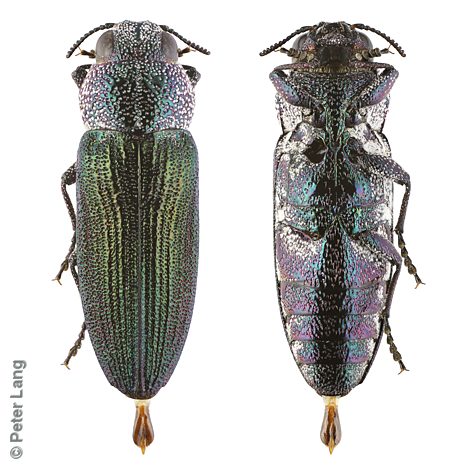
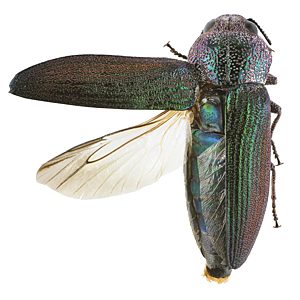
, EP, A7_x300.jpg)
, EP, A8_x300.jpg)
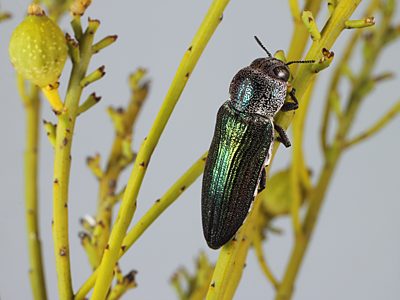
 , EP, A10_x300.jpg)
, EP, A11_x300.jpg)
, EP, H1_x300.jpg)
, EP, H2_x300.jpg)
size¹:
×
4.2 mm
, EP, A1_x468.jpg)
, EP, A2_x468.jpg)
, EP, A3_x468.jpg)
, EP, A4_x468.jpg)


, EP, A7_x300.jpg)
, EP, A8_x300.jpg)

 , EP, A10_x300.jpg)
, EP, A11_x300.jpg)
, EP, H1_x300.jpg)
, EP, H2_x300.jpg)
| male | female | |||||
|---|---|---|---|---|---|---|
| L1 | 11.4 | 9.65 – 12.6 | n = 14 | 16.3 | 15.95 – 16.8 | n = 3 |
| L2 | 11.2 | 9.45 – 12.4 | n = 14 | 15.9 | 15.6 – 16.35 | n = 3 |
| W | 3.9 | 3.3 – 4.25 | n = 14 | 5.7 | 5.3 – 6 | n = 3 |
| Legend | L1 | length from clypeus/frons to elytral apex (mean, range, sample size) |
| L2 | length from anterior of edge of eyes to elytral apex | |
| W | maximum width with elytra fully closed |
Pronotum globose with rounded sides and large deep puncta; overall a dark blackish purple with varying amounts of violet, blue or green; has white powdery material ('mealiness'), mainly within puncta on head, pronotum and ventral side. Elytra with many relatively shallow, closely spaced ribs and shallowly scalloped apices that are weakly spinose or bispinose.
Two specimens of this species were collected on Kangaroo Island in 1878 by Waterhouse, as noted by Matthews 1985. Apart from this the species was only known in SA from old collections without specific localities, and a dead salt lake specimen, until the discovery of its larval host plants by Lang & Stolarski 2020. The host plant species are generally uncommon and patchily distributed which is probably a contributing factor to the species' rarity.
| Legend | P.J.Lang collection vouchered records | |
| other private collection or museum specimens, or sightings |
|
|
|
|
|
|
|
|
|
|
|
|
|
||||||||||||||||||||||||||||||||||||||||||||||||
|
|
|
|
|
|
|
|
|
|
|
|
|
||||||||||||||||||||||||||||||||||||||||||||||||
|
|
|
|
|
|
|
|
|
|
|
|
|
||||||||||||||||||||||||||||||||||||||||||||||||
| Jul | Aug | Sep | Oct | Nov | Dec | Jan | Feb | Mar | Apr | May | Jun |
| Legend | ||
9 | number of active beetles, actually recorded in that quarter-month | |
2 | estimate of active beetles, inferred* from adjoining date ranges | |
| actual count > 6 (mean) | ||
| actual count <= 6 (mean) | ||
| inferred* active beetles only (mostly from colour lure trap results) | ||
| live non-emerged (inactive) beetles only | ||
| *Inferred when a site has counts of active beetles for each of two consecutive
periods (date ranges), one finishing and the other starting in the same
quarter-month. The count estimate is assigned to that quarter-month and calculated as the lower of the two total beetle counts, divided by the number of quarter-months in its date range. Assumes that beetle activity is essentially continuous within a single active period per year, and that date ranges do not bridge a non-active period (thus only ranges of < 4 months are used). | ||
| beetles | sites | SA regions¹ | family | position on host plant | ||
| Choretrum chrysanthum | 9 | 1 | EP | S | ||
| Choretrum glomeratum | 3 | 1 | SE | S |
| Legend | beetles | count of beetles collected from, or sighted on, host plant taxon |
| sites | count of major sites (unique 10 km grid cells +/- some distinct approximate localities) | |
| Plant names in green are hyperlinked to a matching host species page with plant photos. | ||
| Code | beetles | % | host plant taxa | |
| S | Santalaceae | 12 | 100% | 2 |
| position | beetles | sites | |
| on foliage or non-flowering plant | 12 | 2 |
| colour | beetles | sites | SA regions¹ | |
| yellow | 7 | 1 | SE | |
| bright green | 1 | 1 | SE | |
| dark violet | 1 | 1 | SE |
 stem base, SE, dorsal (above) & ventral (below), L1_x300.jpg)
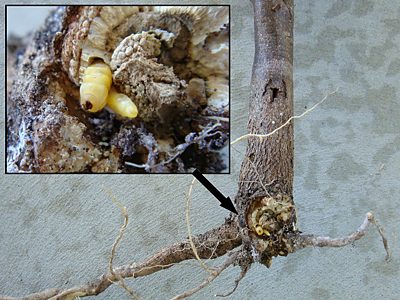
 stem base, SE, photo by A.M.P. Stolarski, Castiarina larva on RHS, L1.2_x300.jpg)
 stem base, SE, photo by A.M.P. Stolarski, L1.3_x300.jpg)
, SE, photo by A.M.P. Stolarski, L1.5_x300.jpg)
, SE, photo by A.M.P. Stolarski, L1.6_x300.jpg)
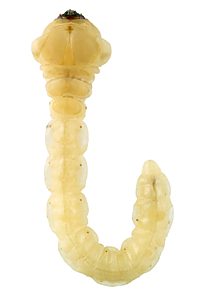
, SE, dorsal & ventral, L3_x300.jpg)
, dorsal, SE, L5_x300.jpg)
, ventral, SE, L6_x300.jpg)
, dorsal, SE, L7_x300.jpg)
, ventral, SE, L8_x300.jpg)
 stem, dorsal, EP, L9_x300.jpg)
 stem, ventral, EP, L10_x300.jpg)
 stem base, dorsal (above) & ventral (below), SE, L11_x300.jpg)
 stem base, ventral & dorsal, SE, L12_x300.jpg)
 stem base, EP, photo by A.M.P. Stolarski, L13_x300.jpg)
 stem base, EP, photo by A.M.P. Stolarski, L14_x300.jpg)
 stem base, EP, N1_x300.jpg)
 stem base, EP, N2_x300.jpg)
 dead stem base, SE, photo by A.M.P. Stolarski, N3_x300.jpg)
 dead stem base, dorsal & ventral, SE, photo by A.M.P. Stolarski, N4_x300.jpg)
 exposed root, EP, P1_x300.jpg)
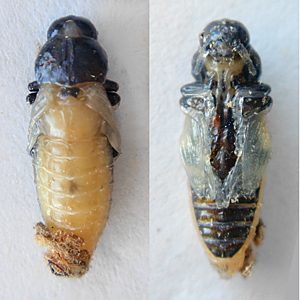
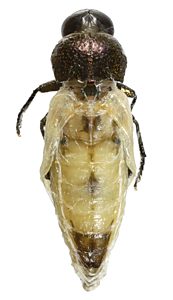
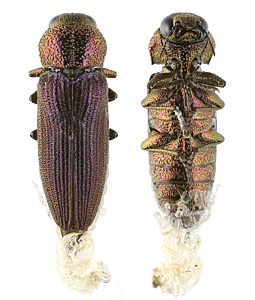
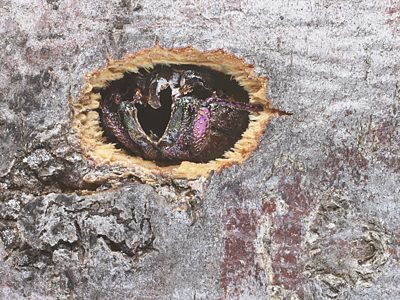
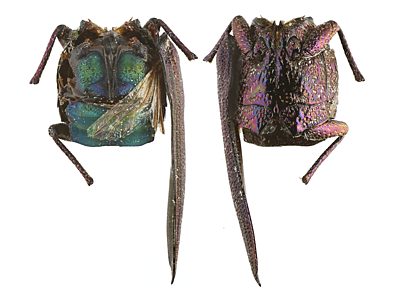
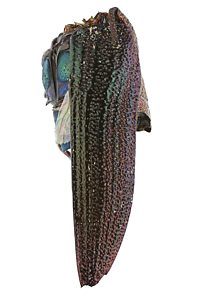
 mostly dead stem base, EP, D6_x300.jpg)
 mostly dead stem base, EP, D7_x300.jpg)
 mostly dead stem base, EP, D8_x300.jpg)
 mostly dead stem base, EP, D9_x300.jpg)
 mostly dead stem base, EP, D10_x300.jpg)
, frass-filled tunnels continuous to pupal chamber, SE, B1_x300.jpg)
, fresh exit hole, EP, B2_x300.jpg)
, fresh exit hole, EP, B3_x300.jpg)
, fresh exit holes, EP, B4_x300.jpg)
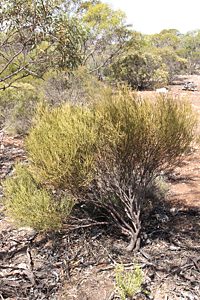
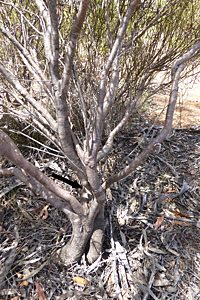
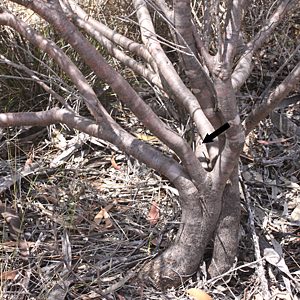
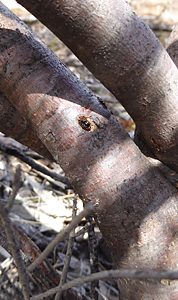
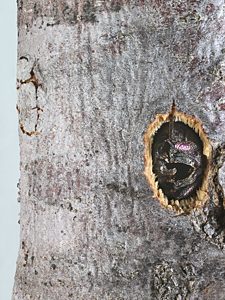
, SE, photo by A.M.P. Stolarski, B11_x300.jpg)
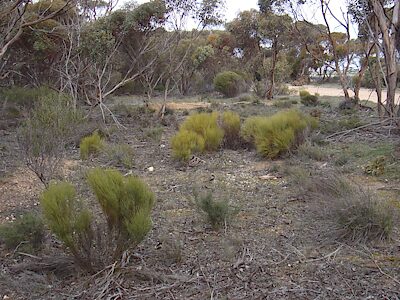
, SE, photo by A.M.P. Stolarski, exposed root with exit hole, B13_x300.jpg)
| records | sites | SA regions¹ | family | adult live | adult dead | adult ex pupa | pupa | larva | |
| Choretrum glomeratum | 21 | 8 | EP, SE | S | 3 | 1 | 3 | 14 | |
| Choretrum chrysanthum | 12 | 5 | EP, SE | S | 2 | 10 | |||
| Leptomeria aphylla | 3 | 2 | SE | S | 1 | 2 |
| Legend | records | count of breeding adults, pupae and larvae |
| sites | count of major sites (unique 10 km grid cells +/- some distinct approximate localities) | |
| adult | live = extracted alive; dead = extracted dead as intact or fragmentary remains; ex billet = reared and emerged from stored sections of host; ex pupa = reared from sampled pupa | |
| pupa | extracted pupa; pupa ex larva = reared pupa from larva | |
| larva | extracted larva (any stage including prepupa) | |
| gall (only) | hatched or unhatched gall identified by form and position rather than contents | |
| Plant names in green are hyperlinked to a matching host species page with plant photos. | ||
| Code | records | % | host plant taxa | |
| S | Santalaceae | 36 | 100% | 3 |
| position | records | sites | adult live | adult dead | adult ex pupa | pupa | larva | |
| root | 1 | 1 | 1 | |||||
| root crown | 1 | 1 | 1 | |||||
| stem base | 17 | 6 | 1 | 1 | 15 | |||
| stem | 10 | 7 | 1 | 1 | 1 | 1 | 6 | |
| dead stem | 5 | 4 | 1 | 1 | 3 | |||
| unknown | 2 | 2 | 1 | 1 |
Various life stages of M. globithorax have been found at diverse locations in live stems of three shrub species of family Santalaceae: Choretrum chrysanthum, C. glomeratum and Leptomeria aphylla. Continuity of frass-filled tunnels indicates that larvae feed downwards, starting from small upper branchlets as narrow as c. 2 mm diameter to eventually pupate in the trunk or main stems near the plant base, and this is supported by observations of ovipositing behaviour (Lang & Stolarski 2020).
In WA, adults have been mostly attracted to yellow lures (T.M.S. Hanlon & M. Powell 2020, pers. comm), as is the case in SA. This accords with the foliage colour of the Sour-bushes that are its main larval host plant species: in Choretrum chrysanthum it is greenish yellow or golden yellow, and in C. glomeratum it is pale and whitish but often tinged with greenish yellow.
| ¹ Legend | regions | SA State Herbarium regions (map) EA: Eastern, EP: Eyre Peninsula, FR: Flinders Ranges, GT: Gairdner-Torrens, KI: Kangaroo Island, LE: Lake Eyre, MU: Murray, NL: Northern Lofty, NU: Nullarbor, NW: North-Western, SE: South-Eastern, SL: Southern Lofty, YP: Yorke Peninsula |
| size | The ellipse is the correct size when printed, indicative on a desktop screen, and likely to be wrong on a mobile device. |